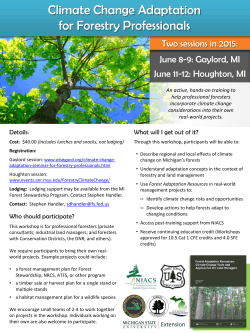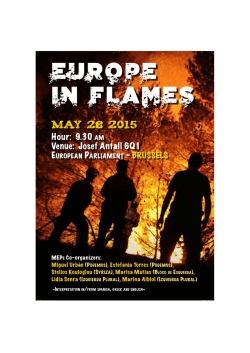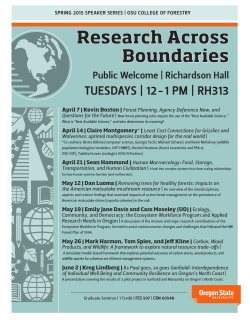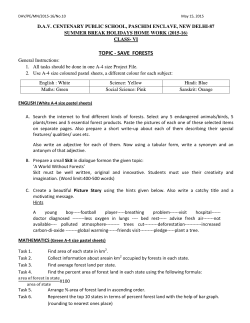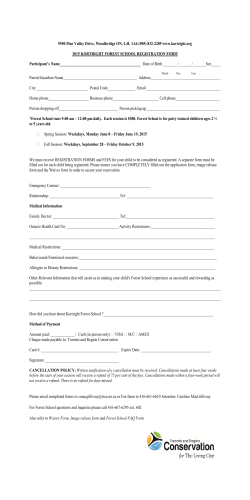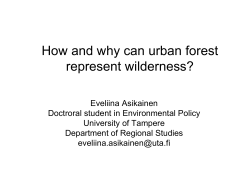
five things that matter in predicting disturbances & ecosystem
FIVE THINGS THAT MATTER IN PREDICTING DISTURBANCES & ECOSYSTEM RESPONSES Richard Waring NASA’s Carbon Cycling and Ecosystems Joint Science Workshop April 20-22th, 2015 st 1 CLIMATIC VARIATION The most general response to climate change is a change in maximum leaf area index 1 m2/m2 2 m2/m2 10 m2/m2 Waring, Coops, Mathys, Hilker, Latta(2014) Process-based modeling to assess the effects of recent climatic variation on site productivity and forest function across western North America. Forests 5:518-534. nd 2 MANAGEMENT PRACTICES Option to thin forests to increase residual tree growth rates and resistance to bark beetles while reducing canopy leaf area 120 year-old lodgepole pine in Oregon’s Deschutes National Forests, photo by R.H. Waring Exposed tree crowns produce more defenses per unit of leaf area against insects than shaded crowns Christiansen, E., R.H. Waring, and A.A. Berryman (1987) Resistance of conifers to bark beetle attack: Searching for general relationships. Forest Ecol. & Mgmt. 22:89-106 Option to make disturbances more frequent but less destructive Photos courtesy of John Bailey, OSU College of Forestry rd 3 BIOLOGICAL DIVERSITY Biological diversity buffers forests against climate change, insects and pathogens SIMILAR WILDFIRE DANGER Eurasia Mostly ground fires Little tree mortality North America Mostly crown fires High tree mortality Rogers et al. (2015)Influence of tree species on continental differences in boreal fires and climate feedback. Nature Geoscience DOI:10.1038/NGE02352 rd 4 SOILS SOIL TEXTURE MAY DETERMINE WHERE INSECT OUTBREAKS OCCUR Peterman and Waring (2015) Overshoot in leaf development of ponderosa pine in wet years leads to bark beetle outbreaks on fine-textured soils in drier years. Forest Ecosystems (in press) Photos courtesy of Dr. Wendy Peterman, Conservation Biology Institute, OR Deeper soils store more water and limit mortality of pinyon pine Mortality, % of total area (2003-2004) 50 40 y = 55.541x-1.453 R² = 0.93 30 20 10 0 Available Soil Water Storage Capacity, mm Peterman, W., R.H. Waring, T. Seager, and W.L. Pollock (2013) Soil properties affect pinyon pine-juniper response to drought. Ecohydrology 6:455-463 5th TREE AGE MATTERS Slide provided by Wendy Peterman Tree Age affects Annual Carbon Budgets Carbon Flux (g C m-2 yr-1) 400 200 Sink Interannual Variability 0 -200 Source -400 -600 0 20 40 60 80 100 120 140 160 180 NOBS UCI1850 SOBS EOBS OJP OA OMW UCI30 WP39 DF49 UCI64 UCI64wet HJP75 F77 UCI81 HDF88 UCI89 F89 HJP94 UCI98 F98 HDF00 HBS00 HJP02 Stand Age (years) Margolis. 2010. The Canadian Carbon Program and Fluxnet-Canada: Advancing our understanding of the carbon cycle of Canada’s forests and Peatlands using a research network approach. 44th Annual Canadian Meteorological and Oceanographic Society. Climate change may result in killing dominant old trees with fragile plumbing Photo by Steve Wondzell Research Scientist, USFS Corvallis, OR Photo by Burke Greer Ph.D. candidate, Oreg. State Univ Soil water deficits combined with high evaporative demand can break water columns in tall trees more easily than in shorter ones Anderegg et al. (2012) Trends in Plant Science 17: 693-700 Tree age also affects the hydrologic balance Old forests use < 50% of the H20 transpired by young forests, even with similar LAI Macfarlane et al. (2010) Transpiration and hydraulic traits of old and regrowth eucalypt forests in southwestern Australia. For. Ecology & Mgmt. 260:96-105 Roberts et al. 2001. Transpiration from Eucalyptus sieberi forests of different ages. For. Ecol. & Mgmt. 143:163-161. THINGS THAT MATTER IN PREDICTING DISTURBANCES & ECOSYSTEM RESPONSES • • • • • CLIMATE FOREST MANAGEMENT BIOLOGICAL DIVERSITY SOILS TREE AGE PROGRESS TO DATE Global satellite monitoring of climateinduced vegetation disturbances Nate G. McDowell, Nicholas C. Coops, Pieter S.A. Beck, Jeffrey Q. Chambers, Chandana Gangodagamage, Jeffrey A. Hicke, Cho-ying Huang, Robert Kennedy, Dan J. Krofcheck, Marcy Litvak, Arjan J.H. Meddens, Jordan Muss, Robinson Negro´ n-Juarez, Changhui Peng, Amanda M. Schwantes, Jennifer J. Swenson, Louis J. Vernon1, A. Park Williams, Chonggang Xu, Maosheng Zhao, Steve W. Running, and Craig D. Allen REVIEW IN: Trends in Plant Science (2015) 20:114-123 Discriminating types of disturbance Landsat B5 Reflectance Harvest Fire Stress Stable Forest 0.40 0.35 0.30 0.25 0.20 0.15 0.10 0.05 2009 2007 2005 2003 2001 1999 1997 1995 1993 1991 1989 1987 1984 0.00 Schroeder et al. (2014) Improving estimates of forest disturbance by combining observations of Landsat time series with U.S. Forest Service Forest Inventory and Analysis data. Remote Sensing of Environment 154:61–73. Measure LAI, invert process-based forest growth model to map soil water storage Coops et al. (2012) Remote Sensing of Environment 126:160-173. http://databasin.org/maps/5ba4c2f2e158403da090f22b024d37e5/active MAPPING FOREST AGE CLASSES Pan et al. (2011) Age structure and disturbance legacy of North American forests. Biogeosciences 8:715-732 Lidar analysis of multi-layered old-growth Douglas-fir/hemlock on the H.J. Andrews Expt. Forest Generated with USFS Fusion program by Keith Olsen, Oregon State University. Slide provided by Dr. Tom Spies, USFS, Corvallis, OR
© Copyright 2026


